Although
slightly smaller than the EOS 10D the overall design and layout
is very similar, and that's really not a bad thing, there was
little about the design of the EOS 10D which drew criticism. A
few subtle changes like larger buttons and the re-location of
button labels have been done to bring the overall look and feel
of the camera more in line with the professional EOS Digitals.
Somehow the EOS 20D feels that little bit more professional than
the EOS 10D, perhaps it's a change to the material used or the
paint but it really does feel even more durable.

Handling
Not surprisingly the EOS 20D feels very much like
the EOS 10D, albeit a little lighter. The EOS 20D is a great
camera to hold and shoot with, it's small enough not to be bulky
and 'weighty' enough (without feeling heavy) to provide a little
weight induced stabilization. It's probably also worth noting
that the rubber used on the rear of the camera and hand grip is
now softer and more sticky than before.
Features
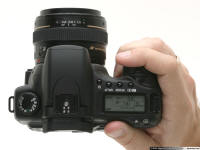
8.2 MP
5 fps with up to 23 frame burst
9-point AF
DIGIC II Processor
E-TTL II distance-linked flash
USB 2.0 Hi-Speed/Video Out
Magnesium alloy body
Compatible with Canon EF/EF-S lenses and EX Speedlite flashes
DPP RAW processing software
Quality
A rugged magnesium alloy body provides the first clue that the
EOS 20D is no ordinary camera. Canon's award-winning CMOS
technology delivers outstanding image quality and 8.2 Megapixel
resolution. The DIGIC II architecture drives blistering 5fps
continuous shooting with a maximum burst of 23 frame JPEG
images, class-leading colour rendition accuracy, quick start-up
times and rapid display and zooming of images during in-camera
review. JPEG and RAW files write simultaneously with no loss of
performance. 9 auto focus points are carefully distributed
across a wide area of the frame for fast, accurate focusing,
even with off-centre subjects and particularly with
'rule-of-thirds' compositions.
Distance-linked flash
The E-TTL distance-linked flash algorithm takes factors such as
lens distance information
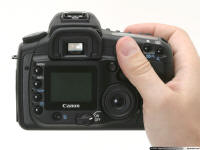 and
ambient light readings into account for accurate flash metering,
even in circumstances such as recomposed shots, or where high or
low reflective objects appear in the frame. The camera is
compatible with the entire EX-series Speedlite flash range. This
includes the 580EX, which transmits colour temperature
information for improved colour stability and auto zooms to
match the camera's APS-C sensor size. The EOS 20D is compatible
with more than 60 Canon EF lenses, including Canon's EF-S
lenses. Built with the EOS 20D photographer in mind, the EF-S
10-22mm f/3.5-4.5 USM and EF-S 17-85mm f/4-5.6 IS USM cover
popular wide (approx. 16-35mm) and standard (approx. 27-136mm)
ranges in the 35mm equivalent.
and
ambient light readings into account for accurate flash metering,
even in circumstances such as recomposed shots, or where high or
low reflective objects appear in the frame. The camera is
compatible with the entire EX-series Speedlite flash range. This
includes the 580EX, which transmits colour temperature
information for improved colour stability and auto zooms to
match the camera's APS-C sensor size. The EOS 20D is compatible
with more than 60 Canon EF lenses, including Canon's EF-S
lenses. Built with the EOS 20D photographer in mind, the EF-S
10-22mm f/3.5-4.5 USM and EF-S 17-85mm f/4-5.6 IS USM cover
popular wide (approx. 16-35mm) and standard (approx. 27-136mm)
ranges in the 35mm equivalent.
LCD Panel
On top of the camera is a large LCD panel which provides a wide
range of information about the current camera settings and
exposure.
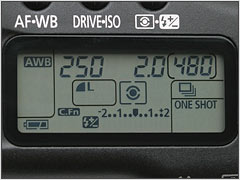 The
main numeric section of the panel doubles up to provide other
types of information such as the 'Busy' warning, ISO setting and
processing parameter set when these are being changed. The panel
has an orange backlight which is illuminated by pressing the
backlight button to the top left of the panel, the backlight
stays on for approximately six seconds.
The
main numeric section of the panel doubles up to provide other
types of information such as the 'Busy' warning, ISO setting and
processing parameter set when these are being changed. The panel
has an orange backlight which is illuminated by pressing the
backlight button to the top left of the panel, the backlight
stays on for approximately six seconds.
Viewfinder
The EOS 20D's viewfinder is clear and bright with a high quality
eyepiece lens (very little corner distortion). It has an all new
'Precision Matte' focusing screen which is supposed to have a
more neutral color response and provide better manual focus with
faster lenses thanks to a steeper change in blur at the focus
point (in use I have to agree, it's a noticeable improvement
over the
 10D.
The rubber surround can be removed and the supplied eyepiece
cover (on the shoulder strap) can be slipped over to stop stray
light from entering the chamber during long exposures. The
eyepiece will also take E-series dioptre adjustment lenses to
further expand the dioptre correction range.
10D.
The rubber surround can be removed and the supplied eyepiece
cover (on the shoulder strap) can be slipped over to stop stray
light from entering the chamber during long exposures. The
eyepiece will also take E-series dioptre adjustment lenses to
further expand the dioptre correction range.
Through the viewfinder you'll see
the partial metering circle and the nine focus points of the new
AF system. In automatic AF point selection mode the AF points
chosen by the camera are highlighted when you initiate AF
(half-press shutter release / AF button), otherwise the selected
AF point is highlighted*. In the example below all AF points are
illuminated, this would only occur if you had pressed the AF
point button with all points selected.
Battery Compartment
The battery compartment on the EOS 20D is in the base of the
hand grip, behind a simple clip- locked door. The door itself is
removable (to make way for the optional battery grip).
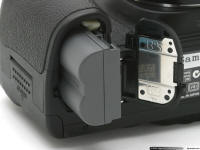 The
EOS 20D is supplied with the higher capacity BP-511A Lithium-Ion
battery pack, it provides 1390 mAh at 7.4 V which is 10.3 Wh vs.
the older BP-511's 8.1 Wh, this will no doubt mean longer
battery life. There's a tiny door on the inside edge of the hand
grip where the cable from the optional AC adapter's dummy
battery exits.
The
EOS 20D is supplied with the higher capacity BP-511A Lithium-Ion
battery pack, it provides 1390 mAh at 7.4 V which is 10.3 Wh vs.
the older BP-511's 8.1 Wh, this will no doubt mean longer
battery life. There's a tiny door on the inside edge of the hand
grip where the cable from the optional AC adapter's dummy
battery exits.
Battery Grip (optional)
Because of its smaller dimensions the EOS 20D gets a new
battery grip, the BG-E2. This provides additional battery
capacity as it can take two BP-511A (or BP-511/512/514)
batteries. Also supplied is a new six AA battery magazine which
is described by Canon as for 'get you home' use only (this
basically means that the camera will soon suck a set of AA's
dry). Compared to the EOS 10D's BG-ED3 the new grip gets an on/off switch (to help avoid accidental shutter
release).
new grip gets an on/off switch (to help avoid accidental shutter
release).
The grip is attached to the EOS 20D by removing the battery
compartment door (which fits neatly into a slot on the edge of
the inserted part of the grip), inserting into the battery
compartment and screwing tightly to the tripod mount. The grip
and two batteries adds 374 g (13.2 oz) to the weight of the EOS
20D with just one battery.
CompactFlash Compartment
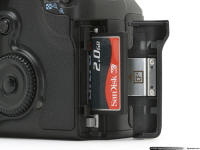 The
CompactFlash compartment on the EOS 20D is at the rear corner of
the hand grip and is opened by sliding the door towards you and
flipping outwards. The door itself has a metal hinge and opens
with plenty of room to remove the CF card once ejected. It's
worth noting that the CF activity light has moved from a hole in
the compartment door to just below the quick control dial on the
rear of the camera. The EOS 20D supports both Type I and Type II
CompactFlash cards and cards greater than 2 GB in capacity
(FAT32).
The
CompactFlash compartment on the EOS 20D is at the rear corner of
the hand grip and is opened by sliding the door towards you and
flipping outwards. The door itself has a metal hinge and opens
with plenty of room to remove the CF card once ejected. It's
worth noting that the CF activity light has moved from a hole in
the compartment door to just below the quick control dial on the
rear of the camera. The EOS 20D supports both Type I and Type II
CompactFlash cards and cards greater than 2 GB in capacity
(FAT32).
Flash
The EOS 20D features an all new E-TTL II pop-up flash, the
flash itself raises much higher than the EOS 10D's unit which
means fewer problems with lenses causing a shadow and
 will
probably improve red-eye performance. The internal lens has a
guide number of 13 (approx. 3.3 m @ 17 mm / 2.3 m @ 85 mm; ISO
100) and a wide angle coverage of 17 mm. Support for E-TTL II
means that lens distance information is now used to calculate
the required flash power. Flash sync speed is up slightly to
1/250 sec. The EOS 20D's hot-shoe can be used with Canon and
third party flash units (sync only). As with the internal flash
the hot shoe supports the new E-TTL II metering which uses
distance information from the lens to calculate flash power.
This works with all Canon lenses (although distance information
is only provided by lenses with ring type USM motors).
will
probably improve red-eye performance. The internal lens has a
guide number of 13 (approx. 3.3 m @ 17 mm / 2.3 m @ 85 mm; ISO
100) and a wide angle coverage of 17 mm. Support for E-TTL II
means that lens distance information is now used to calculate
the required flash power. Flash sync speed is up slightly to
1/250 sec. The EOS 20D's hot-shoe can be used with Canon and
third party flash units (sync only). As with the internal flash
the hot shoe supports the new E-TTL II metering which uses
distance information from the lens to calculate flash power.
This works with all Canon lenses (although distance information
is only provided by lenses with ring type USM motors).
Black & White Mode
The EOS 20D features a new Black and White parameter set. In
this mode you can choose the B&W filter and toning effect in
addition to contrast and sharpness. The sample below was
produced from a single RAW file converted by EOS Viewer Utility
with different B&W settings (the same result as taking multiple
shots in each B&W mode). In addition you can also add toning to
these filters. Place your mouse over the label below the chart
to see that image.
Conclusion
If you've ever handled an EOS 10D and you pick up the EOS-20D you'll be immediately struck by how
much smaller and lighter the camera feels, whilst retaining its
build quality and sturdiness. The body adds to
the feeling of quality, but the optional battery grip and
accessories are not equal to this high standard, which is a real
shame. The auto focus is a considerable improvement over the 10D
being fast and extremely positive. The start up time of less
than 0.2 of a second is virtually instant and the write speeds
are excellent. An improvement in Image quality is also evident
although it is not a massive leap over the already excellent
10D. The upgrade is worth it in terms of speed of operation,
accuracy of auto focus and improved all-round performance, but
probably not in terms of sheer image quality.